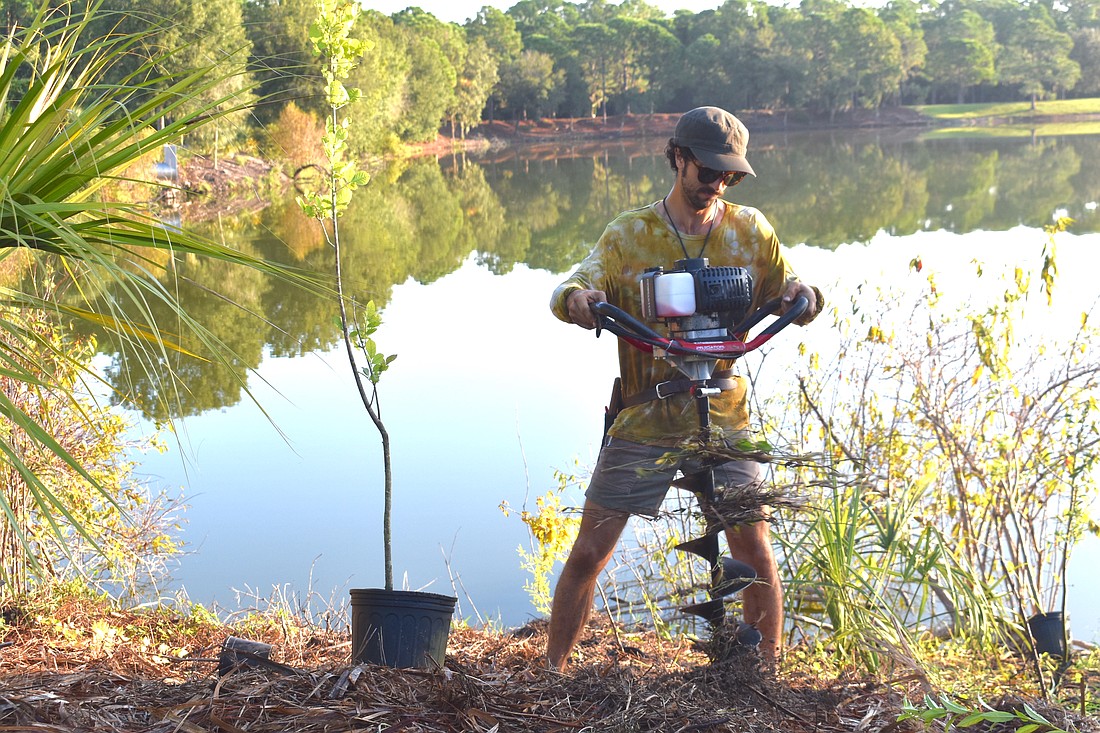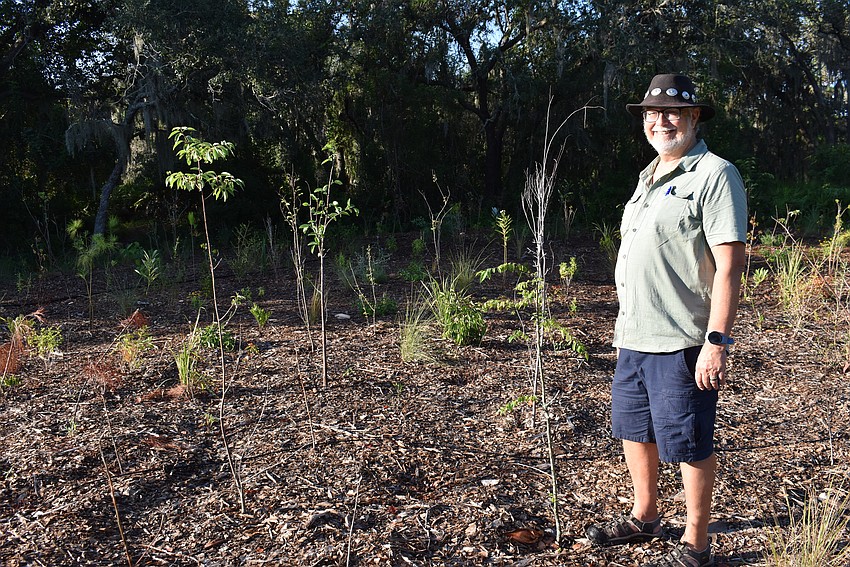- May 3, 2025
-
-
Loading

Loading

Restoration ecologist Charles Reith walked through the new microforest at Heron's Nest Nature Park in Lakewood Ranch on Sept. 13 and briefly stopped smiling to issue a warning.
"No one microforest is going to do it," he said of the moves in urban areas to plant microforests to combat the effects of global warming. "If we want the Suncoast to adapt to higher temperatures, and more intense storms, we need to have these microforests widespread. We have planted seven so far, three in Manatee County and four in Sarasota. But we need more. These microforests act as a cooling shield, and they calm the winds."
Reith is the vice president and driving force behind Suncoast Urban ReForesters, a coalition of local nonprofit organizations that include the Florida Veterans for Common Sense, Solutions to Avoid Red Tide, and the Sarasota Bay Rotary Club.
Included in his experience has been, according to his SURF bio, "the development and implementation of restoration and, where necessary, decontamination plans for deserts, wetlands, prairies and forests in 20 countries on five continents. He has been a professor at four universities and worked as a technical and management consultant to corporations, municipalities, and government ministries."
Although the Heron's Nest Nature Park project covered only .3 of an acre along the lake, Reith said it packs a powerful punch for the environment.
"Every microforest is extremely valuable," Reith said. "They can offset flooding, and this one is special because it is on a lake. The planting we are doing is going (from the bank) into the water, and will serve to filter pollutants that normally would go right into the water. This all goes to protect our coastal waters."
The Rotary Club of Lakewood Ranch saw the value of microforests and raised the money to hire experts such as Reith and his SURF coalition to lead the effort at Heron's Nest Nature Park.
"We know that lawns are not the most productive (things to plant) for the environment," said Randy Price, who is the co-leader of the environmental committee for the Rotary Club of Lakewood Ranch. "I met with Charles (Reith) and he explained to me about microforests. It was fascinating."

Perhaps the most fascinating aspect to Rotary Club members was that a microforest, according to Reith, can grow to the size of a 100-year forest in 10 years.
"It is fast," said Price, who said Rotary Club members were impressed they could have such an immediate impact. "And we know plants have positive effects on climate change. We hope a lot of small successes can add up to something bigger. Florida is heating up quickly. This is something local we can do."
Price, whose background has been environmental work for companies such as Con Edison, Honeywell and DuPont, said Rotary member John Freeman had wanted to start a program planting trees locally. Then Price met Reith and he and Freeman decided to be co-leaders of a microforest project, the club's first such project.
CDD1, which has Heron's Nest Nature Park in its district, offered to give the project $3,000 "seed" money, the Rotary Club committed to raising $10,000 to $12,000 to dedicate to the project.
A "cardboard day" was held in June with 15 Rotary Club members on hand to spread cardboard, which "cooks the soil," over the .3 acre to prepare the soil for planting. In August, the first planting was held at the site with more than 40 volunteers from the Rotary and residents from the surrounding neighborhoods.
More than 1,500 trees and plants have been introduced to the site. Among the trees will be sycamores, red maples, oaks, magnolias, hickory and long leaf pine.
The Rotary Club also has picked out two possible sites for future projects — one in the Adventure Park as CDD4 has offered $3,000 in seed money, and another at the corner of Gatewood and 117th St. E. in Lakewood Ranch.
"I will say we will take a deep breath and next spring go for another project," Price said.
Price said his personal feeling is that the Rotary Club should only back microforest projects in areas where the general public can enjoy them, which means nothing behind gates.
Reith hopes SURF can be part of future projects by the Rotary Club of Lakewood Ranch.
"The most important goal I have is for communities to recognize they would like to have one of these," Reith said. "There is so much to gain. I want to usher microforests through the approval process. We can help find the money. I provide the expertise, provide a host contribution, find money through grants."
Reith has enlisted some powerful environmental forces to work with him on such projects, such as Lonnie Ready, who is president of Solutions to Avoid Red Tide, and has had a lifelong passion for aquatic environments and aquatic biology. Ready has worked in the aquaculture and ornamental aquatics industries for 45 years and is a Master Gardener. He was on hand Sept. 13 as volunteers planted the remaining section of the microforest on the banks of the lake.
"This is about cleaning up our waterways and preventing excess nutrients from getting into the gulf," Ready said. "Microforests contribute to filtering those contaminating nutrients. Sixty percent of the nutrients that fuel red tide come from stormwater."
Since the work Sept. 13 was trickier on the bank, few volunteers were recruited because Price was concerned someone might fall and get hurt.
Among the trees being planted on the bank were red maples and bald cypress, which adapt well to being close to the water on a bank. Several different bushes and grasses also were being planted.
During the planting, Dave Taylor of the Florida Veterans for Common Sense was video recording everything in the hope of having promotional material for future projects.
"The microforests give you a sense of calmness," said Taylor, a Vietnam veteran who was a Purple Heart recipient. "I am an outdoorsy person. As an ex-soldier, I like it to be calming and peaceful. And more forests mean cleaner air."

Price noted that this particular project was unique because it included an irrigation system that pumped water out of the lake using power generated by solar panels. He said the irrigation system only is temporary until the plants and trees get established.
Reith said the system of planting is called the Miyawaki method. Japanese botanist Akira Miyawaki developed the systems, which plants trees closer together to get "shade signals" which makes them grow fast in height to seek sunlight.
He headed the planting of a microforest in Heritage Harbour that was finished in January.
'That cost $35,000, but it was the Lamborghini of microforests," he said.
The other Manatee County microforest by SURF was planted in June 2022 in Colony Cove in Ellenton.
While Reith's group has the expertise, he said the Heron's Nest Nature Park microforest wouldn't have happened without the Rotary Club of Lakewood Ranch's investment of both money and resources.
"They stepped up and did it all," Reith said. "This excites me because development is destroying acre upon acre and we are so vulnerable to climate change. It has been so satisfying to work on what I believe is the most needed intervention, so we can make this place a safer place to live.
"Each quarter acre we plant offsets an acre of damage caused by developers. We can refit it to these high performance systems. They all will go between neighborhoods, in our parks and next to churches. We are transforming the land."